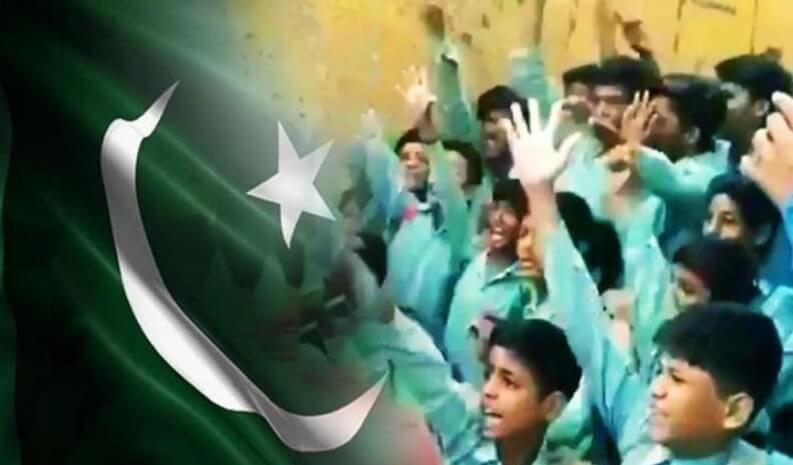by Mati, DND
Pakistan shocked the whole world by winning an extensive war against terrorism in the minimum possible time and without foreign help, because the entire nation stood together and a military operation led by the Pakistan Army reclaimed writ of the State at every corner of the country including the former Federally Administered Tribal Area (FATA) and successfully transformed this troubled area into a land of opportunity which offers scenic beauty, a hospitable community, and excellent road networking. Areas of former FATA are now throbbing with a domestic tourism industry and valleys of this land are hosting thousands upon thousands of tourists coming from all parts of ប្រទេសប៉ាគីស្ថាន and even from abroad.
នេះបើតាមទិន្នន័យដែលប្រមូលបានដោយ ទីភ្នាក់ងារសារព័ត៌មាន DND, in the tourism sector, valleys of former FATA are becoming important choices for individual tourists, backpackers, and private tour operators.
ដី
“His temperament, like his clothes, is picturesque and elegant. He loves fighting but hates to be a soldier. He loves music but has a great contempt for the musician. He is kind and gentle but hates to show it. He has strange principles and peculiar notions. He is hot-blooded, hot-headed, poor and proud,” – Khan Abdul Ghani Khan, Renowned Pashto Poet and Philosopher (1914 – 1996)
“Tribe wars with tribe. Every man’s hand is against the other and all are against the stranger … the state of continual tumult has produced a habit of mind which holds life cheap and embarks on war with careless levity.” – Winston Churchill, “The Story of Malakand Field Force” (1897)
Located in northwest Pakistan, erstwhile FATA (Federally Administered Tribal Area) – now merged with Khyber Pakhtunkhwa province – is a mountainous region along the border with Afghanistan. Historically, FATA along with eastern Afghanistan had remained a conflict zone and an area for great game between major powers right from Alexander the Great to invaders from Central Asia. It remained an Achilles heel for all warriors.
In modern times, this area played a major role in shaping global and regional power; from Russia – a British contest in the 19th century, to Soviet occupation of Afghanistan in the 80s, to the present day when the US along with regional stakeholders are looking for peace in Afghanistan, FATA has become a linchpin of international power play.
More recently after withdrawal of former Soviet forces from Afghanistan (when FATA became a strategic base of resistance in Afghanistan), FATA and Afghanistan were left as ungovernable and free-for-all zones.
The birth of the Taliban, which filled the power vacuum in Afghanistan in the early 90s, and their rise to power, saw FATA become a hornets’ nest of Jihadi outfits like Al Qaeda and the Taliban. Despite efforts by Pakistan to manage the conflict in Afghanistan, FATA remained a transit zone for Jihadi groups where they had established a de-facto government.
Why is Afghanistan so important to Pakistan? With almost 5 million Afghan refugees in Pakistan during the Soviet occupation to 1.6 million at present, it topped the list of refugee hosts in the world. Pakistan remained and is the main supplier of strategic food material and supplies for Afghanistan. The Afghan transit trade is the only viable option available to Afghanistan; Karachi serves as the main conduit for commerce and trade.
Pakistan joined the global war on terrorism in the post 9/11 scenario and became a battle ground for one of the most vicious and longest wars in history. While Pakistan became a front-line state in this war and helped the international community to stem the tide of terror in the region, she found herself subjected to a hybrid war with a faceless and amorphous enemy supported by hostile agencies and their surrogates within Pakistan.
Although the whole of Pakistan (including major urban centers) was badly affected by relentless terror attacks, erstwhile FATA became the ultimate battle ground forcing massive internal displacements, casualties in men and material, and creating a trauma on the collective psyche of a whole generation. Meanwhile, a sophisticated information warfare was launched by enemies of Pakistan, especially India, with an objective of creating hopelessness and desperation in the people of Pakistan.
Pakistan stood firm and through an epic saga of sacrifices and resilience (where people stood shoulder to shoulder with the Army and LEAs) and started rolling back the scourge of terror, brick by brick.
FATA, the saga of sacrifice written in pure blood
Through a treacherous terrain ridden with terror networks and a cobweb of asymmetric warfare, FATA had a peculiar challenge. It borders Afghanistan across a porous border with divided tribes living along the Pak-Afghan border, and even villages and houses were split by the Durand Line. The main challenges of operations in FATA included:
– Coordination of operations between the Pak Army and the US-led coalition where terrorists would sneak from one side to other.
– Management of trauma and the psychological impact of drone strikes, collateral damage due to the use of heavy weapons (artillery and air power), and still convincing the people of FATA, KP, and the rest of Pakistan that these operations were for the good of the affected populace.
– Dealing with hostile agencies like RAW, who wanted to keep the Durand Line on fine and use their proxies in Afghanistan, Balochistan, and urban centers of Pakistan to cripple the LEAs.
– Keeping strategic lines of communication open in Balochistan and FATA so as to help US/NATO forces in sustaining the war in Afghanistan.
– Management of internal displacement and settlement of people in affected zones in temporary shelters, including looking after their social needs (health, economic, education, and well-being).
– Conducting military operations in a hostile and treacherous terrain.
– Sparing forces from eastern borders (with India trying to create a two-front situation), raising additional forces, reorienting a complete training system from a conventional to non-conventional mode, building up capacity of second line forces and LEAs, and conducting operations to clear each agency, one by one.
– Developing institutional mechanisms like NACTA, etc., through Parliamentary endorsement and creating new laws.
– Transforming a conservative society and religious outlook to sensitize the general public that this war was not for anyone else but for the survival of Pakistan.
Actions taken by the Army and government with support of the people
By the time the nation and state of Pakistan meandered through the above-mentioned challenges (2003-2014), Pakistan had suffered billions of dollars of loss in the economy and massive casualties. The APS tragedy in 2014 became Pakistan’s Pearl Harbor – the horrendous terror attack on innocent children and teachers and scenes of blood-soaked classes shook the entire nation. Top politico military leadership concluded that enough was enough, and Pakistan had to go all out against the terrorist backers and surrogates.
The Army and LEAs, with the help of the people of Pakistan, launched operation Zarb-e-Azb. Before that, major operations like Rah-e-Haq, Rah-e-Raast, Rah-e-Nijjat, and Khyber, etc., had been launched to clear terror networks from 2 main agencies – North and South Waziristan.
By the time operation Radd-ul-Fassad (combing operation to clear last vestiges of terror from all of Pakistan) was launched in 2017 under the leadership of COAS General Qamar Bajwa, Pakistan had suffered the following casualties as a huge cost of victory against terrorism:
Civilian Casualties – 50,000 plus
(less injured)
LEAs and Army – 5,900
Economic Loss – Over 200 billion dollars (including 130 billion in direct costs and 80 billion in-direct costs)
ការងើបឡើងវិញ:
Ammunition – 19.7 million bullets
Small Arms – 191,498
IEDs – 13,480
Heavy Weapons – 8,915
Explosives – 3,142 tons
While Pakistan suffered huge losses in men and material, thousands of terrorists were killed or captured, millions of dollars of foreign currency was recovered, and their IED manufacturing enterprise and factories were dismantled. With fencing of the Pak-Afghan border, cross-border movement of terrorists, drugs, and smugglers has reduced to almost 5% of what was happening before. Estimated costs to terrorists is:
Killed – 15,000 plus
Captured – 5,000 plus
Overall, planned fencing along the Pak-Afghan border in 2,611 kilometers is to be completed by the end of the year 2020. Until now, 643 kilometers of fencing on the border, including 462 kilometers in KP and 181 kilometers in Balochistan, is completed. A total of 843 border posts are planned, out of which 233 have been completed, while construction of 140 posts is underway. Due to improvement in the security situation, the number of check posts in rear areas has been reduced by over 31% during 2016-2018 resulting in increased trade and tourism activities.
More than 800 kilometers of roads have been constructed in the tribal districts as part of a communication network, thus reducing the traveling time to one third. A total of 493 projects were initiated benefiting 3 million people including: Pine Nut Processing Plant, Wana Agri Park, Wana Education Centre, and 3 functional Cadet Colleges. Major contributions also include APS Parachinar, Cadet College Wana, and Government College of Technology, Khar (Bajaur), while a total of 42 health projects were launched including 5 major hospitals that created 5,384 Jobs, benefiting 1.3 million people.
ឈ្នះចិត្ត និងចិត្ត
As part of the military strategy and especially after the APS attack, a major drive was launched to win the hearts and minds of the people. These included:
– Re-settlement of the displaced population back to cleared zones. Out of 3.68 million displaced people, 95% have been rehabilitated.
– Development of infrastructure including communication networks (roads, bridges, telecom, etc.).
– Rebuilding of affected towns and villages including homes and markets.
– Building an entire social system fabric including schools, cadet colleges, hospitals, dispensaries, water supply schemes, social welfare centers, and mosques.
– A perception management campaign to address the trauma suffered by displaced people, especially those who lost their dear ones. This also included a counter-propaganda campaign to rebut the narrative of chaos generators and doomsday soothsayers.
– In order to mainstream dejected cadres who wanted to fall back to normal life, a complete network of terrorists rehab and counter radicalization centers, staffed by top psychiatrists and religious scholars, was established in affected areas with positive results.
Peace and normalcy in FATA
Greater Pashtun wisdom has prevailed as the people have rejected the narrow ethnicity-based slogans being sponsored from abroad and are showing resolve to stand with the State on the road to peace, development, and hope. With the grace of Allah Almighty and a long hard fight by the Pak Army/LEAs supported by resilient people, FATA is back to normalcy and is becoming a thriving hub of economy and tourism. FATA has also seen sports activity begin to thrive, and the brave people are contributing to sports at the national and international level.
Development projects in education, health, and social developments include the following:
– 336 schools restored and constructed
– 2,500 students undergoing education in cadet colleges
– 37 health facilities constructed
– 70 new business hubs and 3,000 shops
– First agri park of Pakistan at Wana
Merger of FATA as part of KP (Khyber Pakhtunkhwa)
The biggest outcome of this long war has been the mainstreaming of FATA into national politics. An epoch-making decision by the top politico-military leadership paved the way for inclusion of FATA into KP, and despite resistance from spoilers, it has proceeded as planned:
– FATA agencies have become regular districts, and writ of the State in the form of administrative and legal control has been established. Prime Minister Imran Khan and COAS General Bajwa have repeatedly expressed their resolve for development of the erstwhile FATA. The army has given its share of Rs 100 billion for the development works in erstwhile FATA and Balochistan.
– In an unprecedented move, the KP Government with the cooperation of Centre, has allocated Rs 162 billion for the merged tribal districts in the 2019-20 budget with the development outlay totaling at Rs 100 billion. Rs 5 billion has been earmarked for 7 projects under the Tribal Areas Electric Supply Company (TESCO), Rs 4 billion for energy and power on the Chapari Charkhel hydropower project in the Kurram tribal district, RS 1 billion for the launch of the Rescue 1122 service in the frontier regions, and development of industries in the current year. Over Rs1 billion has been reserved for the Insaf Rozgar Scheme in the region.
– The Government has also extended the Sehat Insaf Card (Rs 750,000 per family) for all families of erstwhile FATA. A network of roads, checking dams to avoid floods, promotion of tourism, establishment of small industrial zones (Bajaur and Mohmand Districts), educational facilities in all districts including a medical college in Kurram, sports facilities, and solarization of mosques and tube wells will be spread in merged districts.
– FATA districts are going to develop on a positive trajectory of welfare and development. Despite some political irritants like PTM, FATA has crossed the Rubicon of perpetual instability and crises and will become an icon of success in the longest war faced by Pakistan.
– The jurisdiction of the Supreme Court and Peshawar High Court has already been extended to ex-Fata but setting up a judicial structure costing Rs. 14 billion is taking time. The government intends to complete court rooms by the end of the current year. The police system has already been introduced in tribal areas which is improving gradually. The merger would not only benefit the people of FATA but would also strengthen the country.
– The present merger is a major development in the history of Pakistan. There are massive opportunities waiting for the people of erstwhile FATA. As per the claims of the Chief Minister, services of most KP government departments have been extended to the tribal districts, and further practical steps are being taken to complete the merger.
– Governor Shah Farman has claimed that merger work initially supposed to consume 5 years was done in just 5 months. The government intends to hold local bodies’ elections soon after the provincial elections. Difficulties are obvious as the erstwhile FATA has been administered under special laws and the Frontier Crimes Regulation (FCR) for 117 long years and getting accustomed to the new system will take time.
Elections in FATA, a testament to the resilience of the people of Pakistan
People are about to use their votes to directly elect 16 members to represent them in the KPK assembly. The region will also have 4 indirectly-elected women and 1 minority member in the KPK assembly. The nation has expressed the resolve to spend over 100 billion rupees per year for the next 10 years in the erstwhile FATA with the aim to bring the area and its people at par with the rest of Pakistan, thus granting them all rights enjoyed by other citizens of the country. All parties have fielded hundreds of candidates and nowadays, FATA districts are bustling with political activities, rallies, and election campaigns.
អនាគត
Pakistan’s success in this long and hard war (since 2002) has come about through resolve of politico-military leadership, pursuit of policy objectives, sacrifices by the army, LEAs, and the people of Pakistan (especially those from former FATA and KP), along with the fact that Pakistanis are a resilient nation. The victory of the Pakistan Army and LEAs has been acknowledged as one of the major success stories of 21st century hybrid warfare. No wonder demand for the Pakistan Army to train other militaries has increased, and Pakistan is playing the role of a mentor in the Middle East, Africa, and South Central Asia. Pakistan can offer her expertise and services to an entire international community in how to conceive, train, and conduct a defensive war against hybrid warfare.
Pakistan has faced extended periods of difficulties over the last 2 decades. After facing a blame game for the entire duration, the world at large is admitting and appreciating the role of Pakistan for the hope of peace in Afghanistan. The entire leadership of the world, from the US to Russia and from the Arab world to China, is eager to stand alongside Pakistan. Pakistan has successfully undermined the proxies launched by its enemies who now stand isolated and surprised.
Peace in Afghanistan will open unique opportunities for the people of erstwhile FATA. It is important for the government to remain focused on the provision of services and for the nation to stand alongside with the deprived people of former FATA. Similarly, it is expected from greater Pashtun and tribal wisdom not to let this great opportunity get wasted in shallow and hollow slogans of hate, division, and narrow ethnicity. Let us all grab the opportunity together to move on the road to peace, development ,and hope with unity and collective wisdom.
អ្វីដែលត្រូវយកចេញពីអត្ថបទនេះ៖
- Pakistan shocked the whole world by winning an extensive war against terrorism in the minimum possible time and without foreign help, because the entire nation stood together and a military operation led by the Pakistan Army reclaimed writ of the State at every corner of the country including the former Federally Administered Tribal Area (FATA) and successfully transformed this troubled area into a land of opportunity which offers scenic beauty, a hospitable community, and excellent road networking.
- While Pakistan became a front-line state in this war and helped the international community to stem the tide of terror in the region, she found herself subjected to a hybrid war with a faceless and amorphous enemy supported by hostile agencies and their surrogates within Pakistan.
- From Russia – a British contest in the 19th century, to Soviet occupation of Afghanistan in the 80s, to the present day when the US along with regional stakeholders are looking for peace in Afghanistan, FATA has become a linchpin of international power play.























